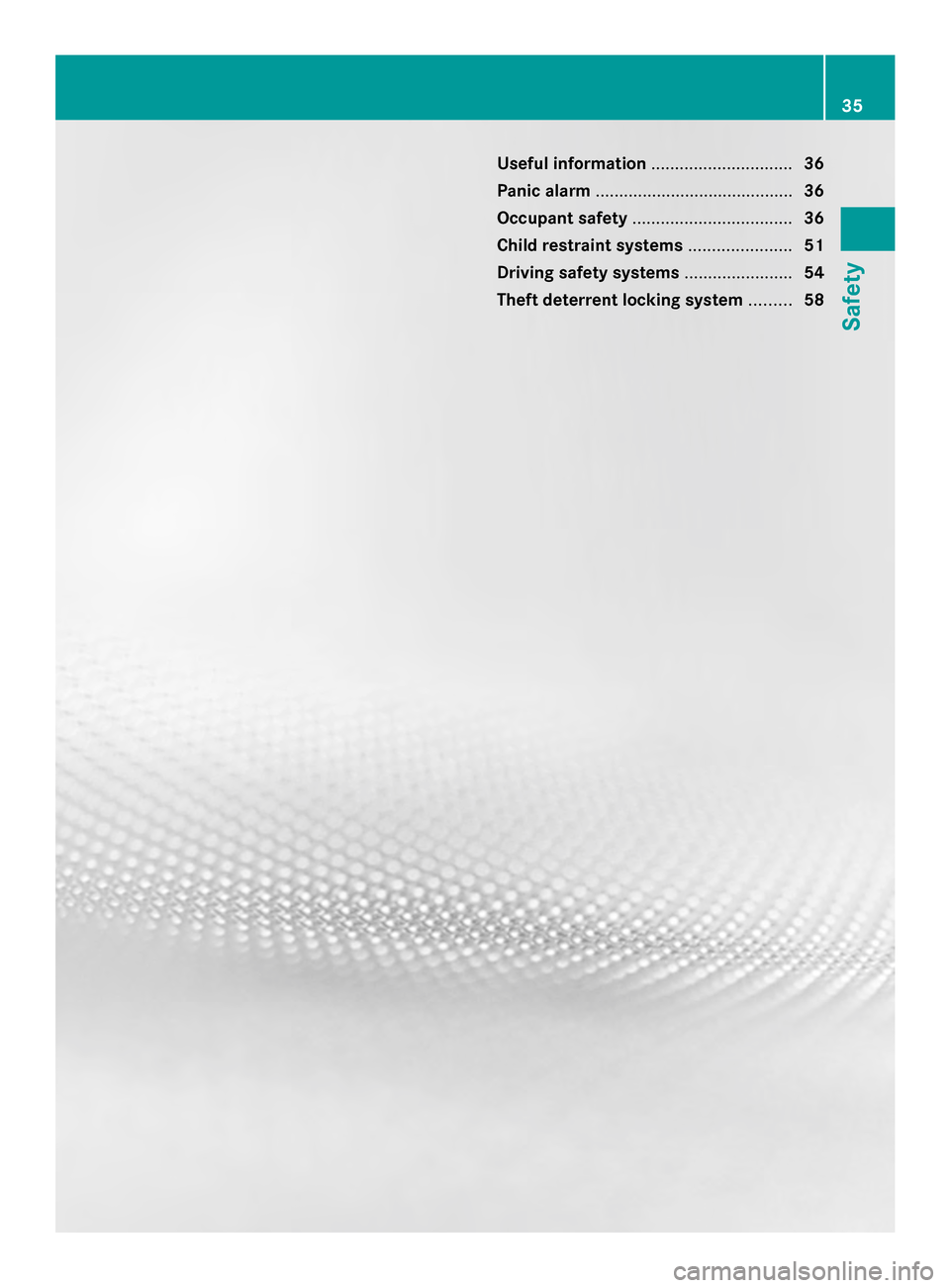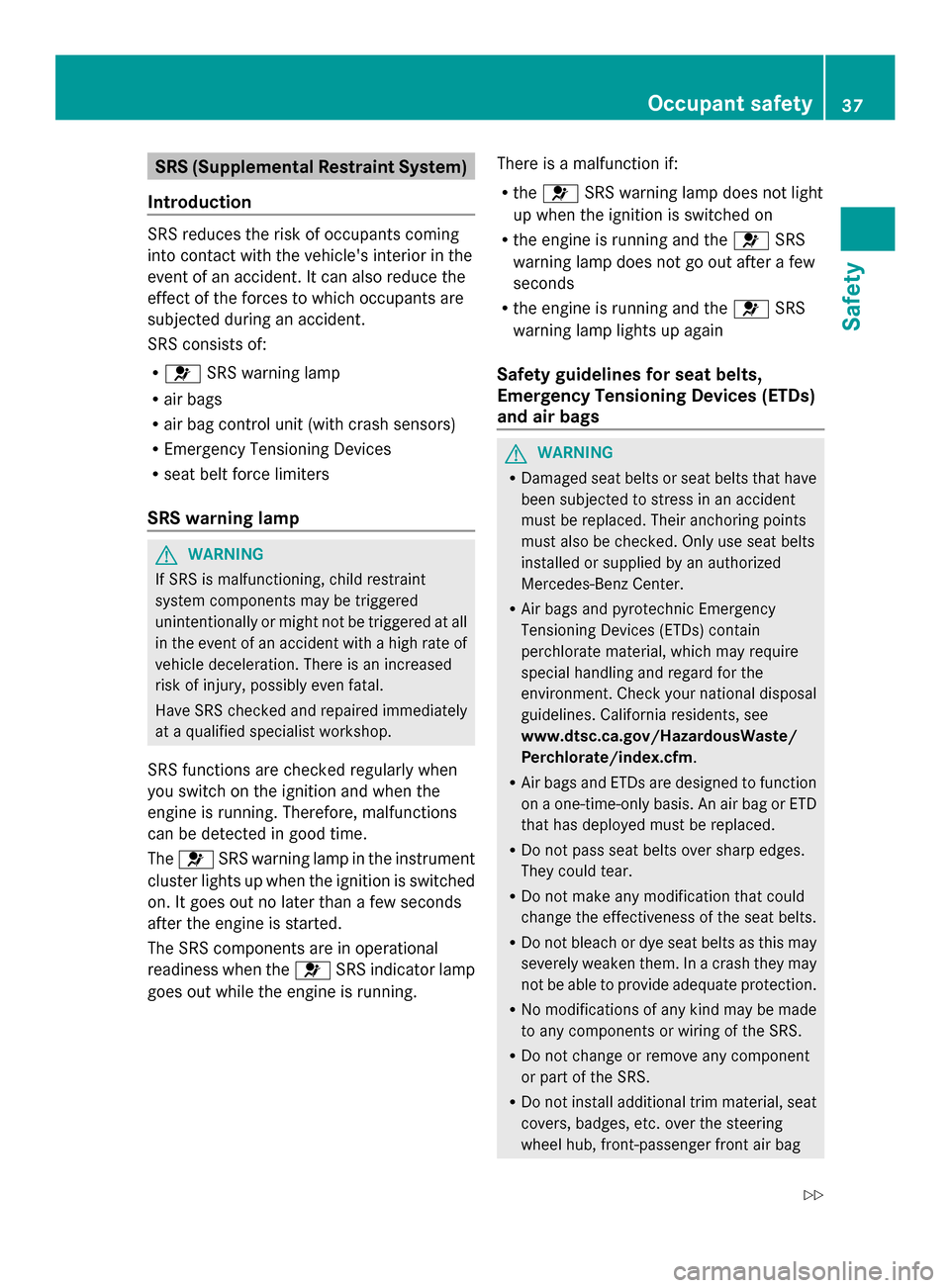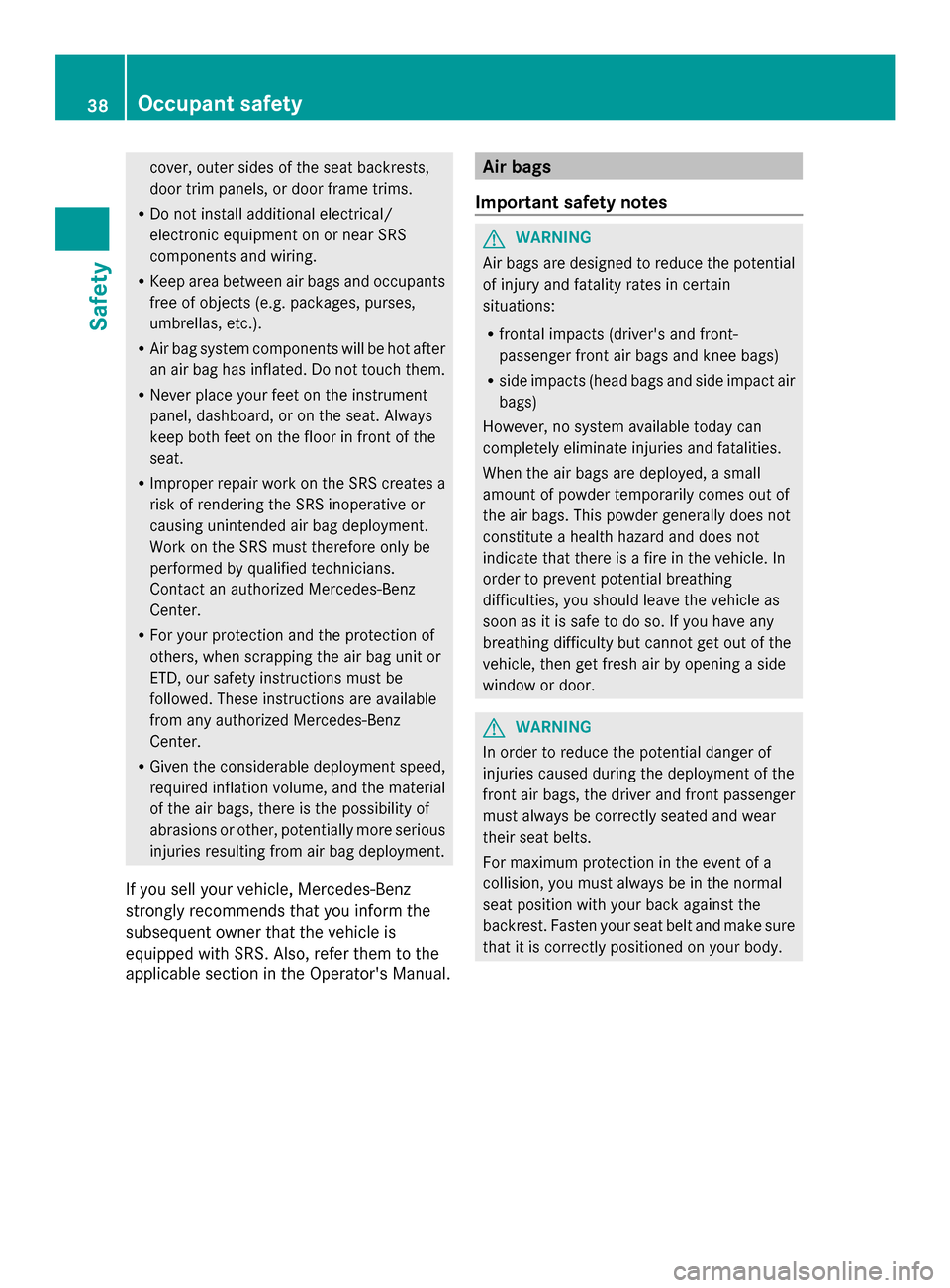MERCEDES-BENZ SLS AMG GT ROADSTER 2014 C197 Owner's Guide
Manufacturer: MERCEDES-BENZ, Model Year: 2014, Model line: SLS AMG GT ROADSTER, Model: MERCEDES-BENZ SLS AMG GT ROADSTER 2014 C197Pages: 290, PDF Size: 3.34 MB
Page 31 of 290

Multifunction steering wheel
Function Page
0043
Multifunction display 152
0044
COMAND with display; see
the separate operating
instructions 0087
00610076
Makes/accepts
or rejects/ends a call 156
00810082
Increases/
reduces the volume 0063
Mute 0085
0059
Switches on the Voice
Control System; see the
separate operating
instructions Function Page
0083
0038
Back or deactivates
the Voice Control System 0084
00590065
Selects a menu 151
00630064
Selects a
submenu or scrolls through
lists 0076
Confirms selections
and hides display
messages Multifunction steering wheel
29At a glance
Page 32 of 290

Center console
Upper section
Function Page
0043
Controls COMAND, see the
separate operating
instructions
0044
Adjusts AIRSCARF, left
(Roadster only)
88
0087
Retracts/extends rear
spoiler (vehicles with AMG
adaptive sport suspension
system)
210
0085
Hazard warning lamps 98
0083
PARKTRONIC
143 Function Page
0084
Adjusts AIRSCARF, right
(Roadster only)
88
006B
Seat heating, right 87
006C
0073
PASSENGER AIR BAG
OFF indicator lamp 42
006D
Operates dual-zone
automatic climate control 107
006E
Seat heating, left 8730
Center consoleAt a glance
Page 33 of 290

Lower section
Function Page
0043
AMG E-SELECT selector
lever
121
0044
COMAND controller
0087
Stowage compartment 201
12 V socket 203
Ashtray 203
Cigarette lighter 203
0085
Stowage compartment with
cup holder 201
0083
Soft top switch (Roadster
only)
79
0084
Ignition lock (behind
stowage space) 119
006B
Calls up/stores AMG menu
(SETUP)
128 Function Page
006C
Adjusts AMG adaptive
sport suspension system
140
Retracts/extends rear
spoiler (vehicles without
AMG adaptive sport
suspension system)
210
006D
Activates/deactivates
ESP
® 56
Activates/deactivates
SPORT handling mode
56
006E
Start/Stop button 119
006F
Selects the drive program 126
0070
Parking lock button
P 121Center console
31At a glance
Page 34 of 290

Overhead control panel
Function Page
0043
003D
Switches the left-
hand reading lamp on/off 99
0044
004A
Switches the interior
lighting on/off 100
0087
0033
Switches the
automatic interior lighting
control on/off 99
0085
003D
Switches the right-
hand reading lamp on/off 99
0083
00D9
MB Info call button
(mbrace system) 207
0084
0053
SOS button (mbrace
system) 205 Function Page
006B
Rear-view mirror 90
006C
Transmitter buttons for the
garage door opener 212
006D
Microphone for mbrace
(emergency call system)
telephone and the Voice
Control System
006E
0052
Roadside Assistance
call button (mbrace
system) 20732
Overhead control panelAt a glance
Page 35 of 290

Door control panel
Function Page
0043
Opens the door 69
0044
00370036
Locks/unlocks
the vehicle 69
0087
0070
Selects the left
exterior mirror 90
0085
00AD
Folds the exterior
mirrors in/out electrically 91 Function Page
0083
0071
Selects the right
exterior mirror 90
0084
0062
Adjusts the exterior
mirrors 90
006B
0062
Opens/closes the
side windows 75Door cont
rol panel
33At a glance
Page 36 of 290

34
Page 37 of 290

Useful information
..............................36
Panic alarm .......................................... 36
Occupant safety .................................. 36
Child restraint systems ......................51
Driving safety systems .......................54
Theft deterrent locking system .........58 35Safety
Page 38 of 290

Useful information
i This Operator's Manual describes all
models and all standard and optional
equipment of your vehicle available at the
time of publication of the Operator's
Manual. Country-specific differences are
possible. Please note that your vehicle may
not be equipped with all features
described. This also applies to safety-
related systems and functions.
i Please read the information on qualified
specialist workshops (Y page 22).Panic alarm
X
To activate: press0033button 0043for
approximately one second.
An alarm sounds and the exterior lighting
flashes.
X To deactivate: press0033button 0043
again.
or
X Insert the SmartKey into the ignition lock.
or
X Press the Start/Stop button.
The SmartKey must be in the vehicle. Occupant safety
Important safety notes
G
WARNING
Modifications to or work improperly
conducted on restraint system components
or their wiring, as well as tampering with
interconnected electronic systems, can lead
to the restraint systems no longer functioning
as intended.
Air bags or Emergency Tensioning Devices
(ETDs), for example, could deploy
inadvertently or fail to deploy in accidents
although the deceleration threshold for air
bag deployment is exceeded. Therefore,
never modify the restraint systems. Do not
tamper with electronic components or their
software.
In this section, you will learn the most
important facts about the restraint system
components of the vehicle.
The restraint system consists of:
R Seat belts
R Child restraint systems
Additional protection is provided by:
R SRS (Supplemental Restraint System)
R Air bag system components with:
-PASSENGER AIR BAG OFF indicator lamp
- Front-passenger seat with Occupant
Classification System (OCS)
Although the systems are independent, their
protective functions work in conjunction with
each other. Not all air bags are always
deployed in an accident.
i For information on infants and children
traveling with you in the vehicle restraint
systems for infants and children, see
"Children in the vehicle" (Y page 51).36
Occupant safetySafety
Page 39 of 290

SRS (Supplemental Restraint System)
Introduction SRS reduces the risk of occupants coming
into contact with the vehicle's interior in the
event of an accident. It can also reduce the
effect of the forces to which occupants are
subjected during an accident.
SRS consists of:
R 0075 SRS warning lamp
R air bags
R air bag control unit (with crash sensors)
R Emergency Tensioning Devices
R seat belt force limiters
SRS warning lamp G
WARNING
If SRS is malfunctioning, child restraint
system components may be triggered
unintentionally or might not be triggered at all
in the event of an accident with a high rate of
vehicle deceleration. There is an increased
risk of injury, possibly even fatal.
Have SRS checked and repaired immediately
at a qualified specialist workshop.
SRS functions are checked regularly when
you switch on the ignition and when the
engine is running. Therefore, malfunctions
can be detected in good time.
The 0075 SRS warning lamp in the instrument
cluster lights up when the ignition is switched
on. It goes out no later than a few seconds
after the engine is started.
The SRS components are in operational
readiness when the 0075SRS indicator lamp
goes out while the engine is running. There is a malfunction if:
R
the 0075 SRS warning lamp does not light
up when the ignition is switched on
R the engine is running and the 0075SRS
warning lamp does not go out after a few
seconds
R the engine is running and the 0075SRS
warning lamp lights up again
Safety guidelines for seat belts,
Emergency Tensioning Devices (ETDs)
and air bags G
WARNING
R Damaged seat belts or seat belts that have
been subjected to stress in an accident
must be replaced. Their anchoring points
must also be checked. Only use seat belts
installed or supplied by an authorized
Mercedes-Benz Center.
R Air bags and pyrotechnic Emergency
Tensioning Devices (ETDs) contain
perchlorate material, which may require
special handling and regard for the
environment. Check your national disposal
guidelines. California residents, see
www.dtsc.ca.gov/HazardousWaste/
Perchlorate/index.cfm .
R Air bags and ETDs are designed to function
on a one-time-only basis. An air bag or ETD
that has deployed must be replaced.
R Do not pass seat belts over sharp edges.
They could tear.
R Do not make any modification that could
change the effectiveness of the seat belts.
R Do not bleach or dye seat belts as this may
severely weaken them. In a crash they may
not be able to provide adequate protection.
R No modifications of any kind may be made
to any components or wiring of the SRS.
R Do not change or remove any component
or part of the SRS.
R Do not install additional trim material, seat
covers, badges, etc. over the steering
wheel hub, front-passenger front air bag Occupant safety
37Safety
Z
Page 40 of 290

cover, outer sides of the seat backrests,
door trim panels, or door frame trims.
R Do not install additional electrical/
electronic equipment on or near SRS
components and wiring.
R Keep area between air bags and occupants
free of objects (e.g. packages, purses,
umbrellas, etc.).
R Air bag system components will be hot after
an air bag has inflated. Do not touch them.
R Never place your feet on the instrument
panel, dashboard, or on the seat. Always
keep both feet on the floor in front of the
seat.
R Improper repair work on the SRS creates a
risk of rendering the SRS inoperative or
causing unintended air bag deployment.
Work on the SRS must therefore only be
performed by qualified technicians.
Contact an authorized Mercedes-Benz
Center.
R For your protection and the protection of
others, when scrapping the air bag unit or
ETD, our safety instructions must be
followed. These instructions are available
from any authorized Mercedes-Benz
Center.
R Given the considerable deployment speed,
required inflation volume, and the material
of the air bags, there is the possibility of
abrasions or other, potentially more serious
injuries resulting from air bag deployment.
If you sell your vehicle, Mercedes-Benz
strongly recommends that you inform the
subsequent owner that the vehicle is
equipped with SRS. Also, refer them to the
applicable section in the Operator's Manual. Air bags
Important safety notes G
WARNING
Air bags are designed to reduce the potential
of injury and fatality rates in certain
situations:
R frontal impacts (driver's and front-
passenger front air bags and knee bags)
R side impacts (head bags and side impact air
bags)
However, no system available today can
completely eliminate injuries and fatalities.
When the air bags are deployed, a small
amount of powder temporarily comes out of
the air bags. This powder generally does not
constitute a health hazard and does not
indicate that there is a fire in the vehicle. In
order to prevent potential breathing
difficulties, you should leave the vehicle as
soon as it is safe to do so. If you have any
breathing difficulty but cannot get out of the
vehicle, then get fresh air by opening a side
window or door. G
WARNING
In order to reduce the potential danger of
injuries caused during the deployment of the
front air bags, the driver and front passenger
must always be correctly seated and wear
their seat belts.
For maximum protection in the event of a
collision, you must always be in the normal
seat position with your back against the
backrest. Fasten your seat belt and make sure
that it is correctly positioned on your body. 38
Occupant safetySafety